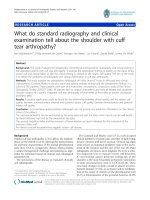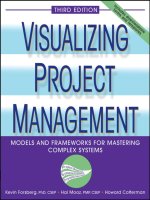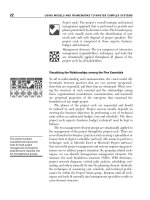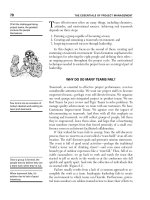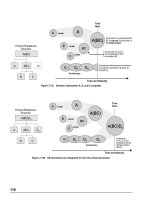Essential tools for organizational performance tools, models and approaches for managers and consultants
Bạn đang xem bản rút gọn của tài liệu. Xem và tải ngay bản đầy đủ của tài liệu tại đây (4.45 MB, 149 trang )
ESSENTIAL
TOOLS FOR
ORGANIZATIONAL
PERFORMANCE
Tools, Models and
Approaches for
Managers and Consultants
Simon A. Burtonshaw-Gunn
and
Malik G. Salameh
ESSENTIAL TOOLS FOR
ORGANIZATIONAL
PERFORMANCE
ESSENTIAL
TOOLS FOR
ORGANIZATIONAL
PERFORMANCE
Tools, Models and
Approaches for
Managers and Consultants
Simon A. Burtonshaw-Gunn
and
Malik G. Salameh
This edition first published 2009
© 2009 John Wiley & Sons, Ltd
Registered office
John Wiley & Sons Ltd, The Atrium, Southern Gate, Chichester, West Sussex,
PO19 8SQ, United Kingdom
For details of our global editorial offices, for customer services and for
information about how to apply for permission to reuse the copyright material
in this book please see our website at www.wiley.com.
The right of the author to be identified as the author of this work has been
asserted in accordance with the Copyright, Designs and Patents Act 1988.
All rights reserved. No part of this publication may be reproduced, stored in a
retrieval system, or transmitted, in any form or by any means, electronic,
mechanical, photocopying, recording or otherwise, except as permitted by the
UK Copyright, Designs and Patents Act 1988, without the prior permission of
the publisher.
Wiley also publishes its books in a variety of electronic formats. Some content
that appears in print may not be available in electronic books.
Designations used by companies to distinguish their products are often claimed
as trademarks. All brand names and product names used in this book are trade
names, service marks, trademarks or registered trademarks of their respective
owners. The publisher is not associated with any product or vendor mentioned
in this book. This publication is designed to provide accurate and authoritative
information in regard to the subject matter covered. It is sold on the
understanding that the publisher is not engaged in rendering professional
services. If professional advice or other expert assistance is required, the services
of a competent professional should be sought.
Library of Congress Cataloging-in-Publication Data
Burtonshaw-Gunn, Simon A.
Essential tools for organizational performance : tools, models and
approaches for managers and consultants / Simon A. Burtonshaw-Gunn and
Malik G. Salameh.
p. cm.
Includes bibliographical references and index.
ISBN 978-0-470-74665-3 (cloth : alk. paper) 1. Organizational change.
2. Knowledge management. I. Salameh, Malik G. II. Title.
HD58.8.B8837 2009
658.4′06—dc22
2009015947
A catalogue record for this book is available from the British Library.
Set in 11.5/15pt Bembo by SNP Best-set Typesetter Ltd., Hong Kong
Printed in Great Britain by TJ International Ltd, Padstow, Cornwall, UK
CONTENTS
ACKNOWLEDGEMENTS
vii
ABOUT THE AUTHORS
ix
INTRODUCTION
xiii
1
PROCESS MANAGEMENT
2
CHANGE MANAGEMENT AND
ORGANIZATIONAL DEVELOPMENT
17
PEOPLE-FOCUSED PERFORMANCE
MANAGEMENT
51
KNOWLEDGE MANAGEMENT AND
PERFORMANCE
79
ORGANIZATIONAL DEVELOPMENT
AND PERFORMANCE THROUGH
COLLABORATIVE WORKING
97
3
4
5
1
REFERENCES
123
INDEX
127
ACKNOWLEDGEMENTS
Having received positive feedback on the publication of
the book The Essential Management Toolbox, which offered
a collection of models and tools that may be used for a
variety of management assignments, the compilation of
this sibling book would not have been possible without
the fine efforts from all those management authors,
research publications and course notes that we have collected over the years to inform and challenge the development of practical approaches to the topics discussed
here. While we have drawn on our own writings and
experience, we remain naturally still indebted to all those
whose work appears in this book, and also to our own
teachers and mentors who have aided our understanding
on many management topics.
We are grateful to the publishers, individuals and
copyright holders who gave their permission to allow
previously published work to be used in this book, and
viii
ACKNOWLEDGEMENTS
while every effort has been made to ascertain copyright
and seek permission we apologize in advance for any
omissions and would be pleased to correct these in any
future edition.
Finally, our huge thanks to all at John Wiley and Sons
for their support, encouragement and the opportunity to
develop the “Management Toolbox” contents in this way.
ABOUT THE AUTHORS
Professor Simon A. Burtonshaw-Gunn has over 30
years’ working experience in both the public and private
sectors covering a range of organizations and industries.
As a practising management consultant he has undertaken
assignments in Asia, North Africa, the Middle and Far
East and Eastern Europe, and currently holds a full-time
position as a Principal Management Consultant for the
international risk management consultancy company,
Risktec Solutions Limited. In addition, he has a pro bono
position as a member of the Court at the University of
Leeds – a member of the Russell Group Association of
the top 20 UK research-intensive universities. To complement this experience he holds two Master’s degrees and
a PhD in various strategic management topics together
with fellowships of four professional bodies including the
Chartered Management Institute (FCMI) and the Institute
of Business Consulting (FIBC).
He was a post-doctoral research fellow for four
years at the Manchester Metropolitan University before
x
ABOUT THE AUTHORS
relinquishing this at the beginning of 2005 to take up the
role of a visiting professor at the University of Salford in
Greater Manchester. Here he served for three years in the
six-star research rated School of the Built Environment
before being appointed as the first visiting professor to the
Salford Business School in 2007. Professor BurtonshawGunn has been a research examiner for the UK’s Chartered
Institute of Purchasing and Supply (CIPS) since 2002 and
is one of the founding members of an international academic research group (ISCRiM) with a focus on supply
chain risk management. In connection with this group he
has presented conference papers in Sweden, the USA, the
UK and Hungary together with a number of refereed
publications, professional journal articles and chapters in
four collaborative management textbooks. On the subject
of risk management he has recently published a book
covering “Risk and Financial Management in Construction”
aimed at industry practitioners and post-graduate students.
His popular book The Essential Management Toolbox, covering management tools, models and notes aimed at students, managers and consultants alike, was published by
John Wiley and Sons in January 2008.
Dr Malik G. Salameh read Aeronautical Engineering
for his first degree, before completing a Master’s degree
in Business and Operations Management and then
specializing in implementing value-based cultural change
within “blue-chip” corporate environments. He holds a
PhD in Management and is an active member of a
number of professional bodies including the Royal
ABOUT THE AUTHORS
Aeronautical Society (MRAeS), the Chartered Institute
of Marketing (MCIM), the Chartered Management
Institute (MCMI) and the Chartered Institute of Personnel
and Development (MCIPD).
Dr Salameh is a practising management consultant
undertaking a wide range of strategic consultancy assignments in the UK and internationally including the Middle
and Far East, North Africa, Eastern Europe, North America
and Asia. His focus includes supporting senior management teams in all aspects of organizational design and
development through to transition and implementation at
both tactical and strategic levels. He actively contributes to
the continued development of his discipline through publications, attendance at CPD lectures, debates and master
classes at Lancaster University Management School, which
is among the top MBA schools in the world and the first
to be awarded a six star rating in the UK. He has also been
selected as post-doctoral examiner for Warwick University
Business School in the UK.
Professor Burtonshaw-Gunn and Dr Salameh have
undertaken a range of management consultancy assignments together both in the UK and in more challenging
international locations where skills, experience and academic knowledge require a wider cultural appreciation,
understanding and respect of the external economic, political, religious and business influences. Over the last four years
they have published a number of joint articles on a range
of business topics with an established house style of combining management theory with practical experience.
xi
INTRODUCTION
This book has been developed from an interest in the use
of management tools and models published in January
2008 in The Essential Management Toolbox: Tools, Models and
Notes for Managers and Consultants. This supplementary
book describes a number of examples and shares the
authors’ practical experiences in the use of appropriate
management tools and models taken from the Toolbox
with a focus on the topic of organizational development
and performance.
As an introduction, this book comprises five broad
and inter-related chapters commencing with Process
Management, leading to Change Management and
Organizational Development, then to People-focused
Performance Management and the role of Knowledge
Management applicable to organizational and individual
performance. The final chapter examines the topic of
organizational development and performance from closer
collaborative-partnered work between organizations.
xiv
INTRODUCTION
Figure 0.1 Development of performance management.
These chapters also present a balance between the
organizations and individual performance commitment,
although clearly both are needed to a greater or lesser
extent in each topic.
It should be noted that the book title reflects that the
narrative describes a range of tools and models on this
important management topic and that the five chapters
may be viewed as standalone topics or as elements of
a systematic approach to organizational development and
performance management. However, in practice, of course,
the five topics will not always be applicable to every
company.
The book is designed to be one of a series of sibling
publications intended to group enabling management
tools, techniques and models into related clusters. These
publications will give managers, organizational leaders and
consultancy practitioners a highly effective means of developing a composite view of an organization and where
INTRODUCTION
necessary helping to apply an appropriate level of intervention to drive performance improvement. Other titles are
Essential Tools for Management Consulting and Essential Tools
for Operations Management.
The structure follows the successful Toolbox formula
of integrating contemporary management tools, techniques and models with those developed from practical
experience of addressing the interconnectedness of a wide
range of organizational challenges across multiple industries. While this approach provides the opportunity to
discuss some new models, the majority of the figures and
models are taken from The Essential Management Toolbox:
Tools, Models and Notes for Managers and Consultants. Where
the original source is not that of the authors then the
source is shown with each model discussed. As with The
Essential Management Toolbox and other books in this series,
full references are provided to guide the reader to where
further information may be found. To assist the reader,
each chapter is punctuated by key theme subheadings to
aid navigation and provide a logical approach to each topic
area together with accompanying explanations intended
to facilitate robust analysis, gain commitment and develop
momentum.
The intent of writing this title has been again to
provide a suitable reference for those currently studying,
newly qualified or promoted managers or those business
leaders wishing to understand and undertake practical
performance improvements relevant to the latest management thinking. The incremental nature of the book
xv
xvi
INTRODUCTION
content is planned to act as a catalyst in reducing the
lead-time to developing practical responses to changes in
market dynamics and assist the application of right-sizing
throughout any organization’s development lifecycle, with
an equal relevance to both the public and private sectors.
It should be noted that both “hard” and “soft” management issues are balanced to help emphasize the importance of symbiotic relationships in engaging people,
achieving high performance and driving innovation
through active knowledge management, all of which has
been covered in this text. Finally, the use of the plan–do–
review theme is deliberate throughout the book to allow
any manager, facilitator or change agent to deliver performance improvement in a structured and effective
format.
CHAPTER 1
PROCESS IMPROVEMENT
DEVELOPMENTS IN PROCESS
MANAGEMENT
Businesses, whether commercial or not-for-profit organizations, inevitably have a wish to remain in operation;
to have sustainable and repeatable business; and to satisfy
stakeholders, customers and employees. For many, this
brings a need to examine their operations in order to
improve and advance such objectives. While organization
change is covered in detail in Chapter 2 and the people
aspects of performance management and organizational
2
ESSENTIAL TOOLS
development in Chapter 3, a deliberate starting point for
such change may be the examination of current practices
and processes. Against this backdrop, process improvement
can be regarded as being a systematic effort to provide
an understanding of every aspect of a company’s processes
in order to reduce rework, variation and needless complexity in order to contribute to its performance through
effectiveness and efficiency. It should be noted that process
identification and redesign only provides a benefit when
it is actually implemented and hence this also suggests a
natural link to a change management programme.
Completion of a process improvement examination
exercise is often seen to be a traditional springboard for
much larger business improvements, which may in turn
incrementally develop into a large-scale change management programme and planned organizational development. Indeed, what may begin as a simple local business
improvement may grow into other initiatives aimed at
delivering more substantial change and hence increased
business-wide implications. The evolution through a range
of such business programmes is shown in Figure 1.1.
With every organizational change there comes a risk
which usually manifests itself through deterioration in
business performance; however, a performance management system with associated key performance indicators
can be used to help management teams predict and mitigate
such an impact. This suggests that process improvement
may be made in conjunction with the introduction of a
change management programme which may be instigated
PROCESS IMPROVEMENT
Figure 1.1 The re-engineering spectrum.
(From Business Process Re-engineering: Myth and Reality. Professor
Colin Coulson-Thomas, 1996, reproduced with permission of
Kogan Page.)
to realign the culture and business targets. Nevertheless,
it should be stressed that the ubiquity of change management initiatives within both public and private sector
organizations can quite often leave stakeholders at all
levels with “change fatigue”, particularly where the vision,
mission and principal objectives become diluted and performance reporting data confused. This said, for any performance-based management system to really add value
to the organization it will need to encourage a no-blame
culture where it will be safe for individuals to highlight
sources of poor performance variance and actually regard
these as proactive opportunities for improvement through
a step change in their process redesign activities prior to
implementation. Common across the re-engineering
spectrum of Figure 1.1 is the requirement to understand
3
4
ESSENTIAL TOOLS
Figure 1.2 Two extremes of undertaking process improvement.
(From The Essential Management Toolbox: Tools, Models and Notes
for Managers and Consultants. S.A. Burtonshaw-Gunn, 2008, reproduced with permission.)
fully the current processes together with a desire to
improve them.
Consequently, it is essential that organizations establish a level of openness and engagement throughout the
process improvement and change management lifecycle,
which transcends policies, procedures and statutory obligations, and carefully consider how critical the involvement of all employees will be in helping deliver process
change. While there are a number of approaches to
change, there are two extremes of major step change –
one being revolution and the other a more gentle, incremental change of evolution with the features of both
shown in Figure 1.2. However, this is not to suggest that
one of these types is good and the other poor as this
choice depends on a range of circumstances and the host
organization’s drivers for change. It should also be noted
that a combination of these approaches is also possible
although the majority of process improvements are aimed
at achieving significant operational and financial improve-
PROCESS IMPROVEMENT
ment; as such, the revolution elements of a business
process re-engineering approach such as process mapping
are commonly adopted.
In considering the other extreme category of process
improvement, the term evolution is aptly used as this
supports a continual activity. Without such commitment,
it is likely that the company’s performance will fail to
keep pace with its competitors and larger change will
more likely then be required. This failure is commonly
referred to as “strategic drift” and is also shown in the
model of Figure 2.2 in Chapter 2.
INVESTIGATING BUSINESS
PROCESSES
While the obvious starting point is to gain an understanding and evaluation of an organization’s current processes
in order to identify where waste and/or rework occurs,
it is also possible to take a more “visionary” approach and
look to producing new processes without the constraints
or inhibitions imposed by an organization’s current operations and capability. This Envision stage exists in the
standard business process re-engineering (BPR) methodology and requires an identification of any gaps to be
undertaken and quantified in order to identify the level
of transition to made to the “to-be” processes of the
organization compared with those of the organization’s
current “as-is” position. A widely employed approach to
BPR is shown in Figure 1.3. As mentioned above, the
5
6
ESSENTIAL TOOLS
Figure 1.3 Business improvement process.
(From The Essential Management Toolbox: Tools, Models and Notes for
Managers and Consultants. S.A. Burtonshaw-Gunn, 2008, reproduced with permission.)
starting point on the model may be either at the Evaluate
or Envision stage, although both stages will need to be
ultimately addressed.
One of the well-known and commonly used models
in Europe is the EFQM Business Excellence model
(covered as Figure 3.2 in Chapter 3), which itself has
similarities to the American “Malcolm Baldrige National
Quality Award”, both of which prompt organizations to
look at their processes and in particular question how
they are developed, used, reviewed and updated. At a
higher level the Business Excellence model also promotes
the use of “best practice” benchmarking with other
companies and places great emphasis on performance
measurement over time allowing trend analysis to be
undertaken. This performance measurement can be from



